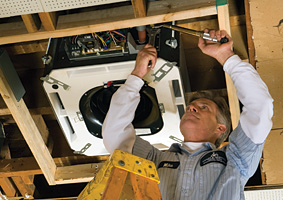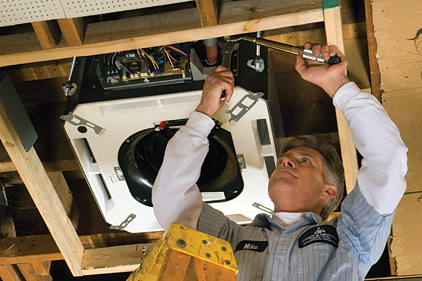Variable-refrigerant flow, or VRF, is working its way into mainstream HVAC. Although not there quite yet, VRF popularity is gaining amongst HVAC contracting companies like Smith Heating and Air Conditioning Inc. in Stockton, Calif.
“VRF systems require unique design criteria in order to maximize the performance and the efficiency of the systems,” said Matthew Smith, who boasts four years of experience with VRF technology as company president. “We have been studying and learning these systems for many years. I believe over the last couple of years — with the need for greater efficiency and operational savings — these types of systems are more acceptable, and we are in a much better position to design and sell them.”
Contractor Commitment Requirements

|
| Contractors across the nation are beginning to see the opportunities variable-refrigerant flow (VRF) equipment offers their businesses. Some have been involved in the technology for years, while others have just started their VRF journey. |
Taking on the design, sales, and installation of VRF requires contractors to make an investment in training. “It is imperative that contractors receive the proper factory training to fully understand the requirements for installation and service,” noted Smith. “VRF systems require a strong emphasis on proper design and installation of the refrigeration piping. The key is in the quality of the technicians that specialize in these types of systems.”
Smith Heating and Air Conditioning Inc.’s 35 employees have installed multiple VRF systems in commercial applications, such as office buildings. Since taking on VRF projects, Smith said the equipment has allowed his company to provide cost and energy savings to customers.
“VRF provides greater HVAC system performance and control with individual zoning and maximizes efficiency provides savings and return on investment,” he explained. “That has been good for our businesses.”
According to Smith, not just any contractor should be installing VRF, even though it is beneficial to HVAC businesses.
“It really requires a full mechanical contractor with complete service both during the construction and after with ongoing service and maintenance of the systems,” he said. “It is crucial the VRF systems are monitored and maintained to manufacturer’s specifications in order to achieve peak performance.”
Specific Skills Necessary
Ask Dave Yates, president of F.W. Behler Inc., York, Pa., how long he’s been involved with VRF systems, and you might hear, “I am pretty sure we entered the VRF market the same day inverter technology arrived in the U.S. that must be close to two decades ago.”
Yates and his company have had diverse experiences with VRF in commercial and institutional settings, even assisting college students in Washington, D.C., during the U.S. Department of Energy’s (DOE) Solar Decathlon. As a planned participant with one project team in the Solar Decathlon, and a second being added in an emergency pinch hit, Yates was exposed to strict scrutiny by a federal inspector who asked a lot of questions before he was willing to allow Yates to continue.
Utilizing his experience, the hours of training, and the multiple installations and service jobs, Yates has built a wealth of VRF knowledge. Amidst other tips, he said it is of the utmost importance that contractors learn how to properly flare copper. He also stressed the importance of learning brazing techniques that use a proper nitrogen purge.
Yates noted that he’s encountered more than a few VRF multi-head systems experiencing problems due to poor flaring techniques.
“Before opening the condenser’s valves to release the system’s charge of refrigerant, purge with process nitrogen; deep vacuum No. 1 using a micron gauge; purge with nitrogen again; deep vacuum No. 2; purge with nitrogen again; and deep vacuum No. 3,” he instructed. “Hold for 30 minutes before releasing the condenser’s refrigerant into the system. Operate the system and obtain superheat and subcooling. Then, adjust the refrigerant charge, if necessary.”
With years of practice and skills under his belt, Yates described his experience with VRF using one statement: “Cha-ching.”
“VRF solutions help me to separate my company from our competitors,” he said. “It also allows me to blend creative designs and solutions to resolve comfort, IAQ, energy conservation, and operating cost issues for our customers.”
Newcomers to VRF
Greg Crumpton, president and founder of AirTight in Charlotte, N.C., said his company’s relationship with VRF only extends 18 months.
“These systems are not your typical split set up. Tubing sizes, charges, and understanding of the sequence of operation are mandatory,” said Crumpton. “There’s no room for cowboys or shooting from the hip.”
He noted that besides the training and education of his technicians and customers, it was imperative to learn when and where to best propose VRF systems.
“They are not fit for all situations,” explained Crumpton. “There is definitely a niche market. Our experience is limited, but it has been very positive and shown us the huge potential of this market.”
While Crumpton touts 18 months of experience, Scott Merritt, owner of Fire and Ice Heating and Air Conditioning Inc., Columbus, Ohio, is still essentially on his first date with VRF.
Merritt and his company started working with VRF equipment a few months ago and has found it imperative to cross train his company so that sales people, technicians, and installers all understand the differences in VRF equipment.
“It is important that you never install what you don’t completely understand,” he explained. “To accomplish this intense training, we have had to change our training agenda quite a bit to get my guys up to speed.”
Although he’s just barely out of the starting blocks, Merritt and his team continues to concentrate on training and educating customers. He’s committed to learning the skill, and is confident it will continue to set him apart from his competitors.
“VRF is the future and you’d better grab a hold of its horns and manage it,” said Merritt. “If you don’t, it will manage you. Simply, you will miss the boat, and that will let your competition run circles around you.”
Publication date: 11/25/2013
Want more HVAC industry news and information? Join The NEWS on Facebook, Twitter, and LinkedIn today!



Report Abusive Comment